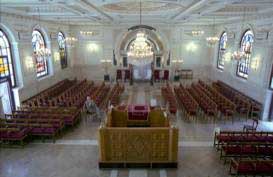The Moroccan Jews: Contradictions Galore
Part 4 of the Oriental Jewish Communities
by Norman Berdichevsky (April 2012)
In 1948, more than 260,000 Jews lived in Morocco, making it the Arab state with the largest Jewish population in the Near and Middle East. It has contributed the largest number of olim (Jewish immigrants to post-1948 Israel) from a Muslim majority country and from many aspects also presented the greatest challenge to the veteran and predominantly Ashkenazi society of the State of Israel (see New English Review “Edot HaMizrah” Israel’s Oriental Jewish Communities</a>; August 2009).
By and large, the older generation of Moroccan Jews living today in Israel do not have bitter memories or hostile sentiments regarding the land of their birth and quite a few have returned to visit the graves of their ancestors.
In 1940, the Nazi-controlled Vichy government issued antisemitic decrees that prohibited Jews from fulfilling any public functions. Sultan Mohammed V refused to apply these racist laws and, as a sign of defiance, insisted on inviting all the rabbis of Morocco to his 1941 coronation anniversary celebrations. For this reason, many Moroccan Jews generally held the King and his royal house during much of the 20th century in high regard although in reality the king was a mere figurehead and had to follow subsequent anti-Jewish directives from the pro-German Vichy government. The participation of Moroccan troops fighting on the Arab side in both the Six Day War of 1867 and the Yom Kippur War of 1973 against Israel was also keenly felt as a stab in the back.
New Moroccan Constitution Proclaims Commitment to Pluralism
The Iraqi Jews – The Oldest Diaspora, Now Safe in Israel</a>; February 2012) feel that their decision to emigrate to Israel, France, the United States Canada and Argentina in the 1950s was a wise one that avoided a potential catastrophe.
Moroccan Jews in Israel
Jewish-Carthaginian Contacts in North Africa
At its height in the 7th century BC (a thousand, three hundred years before the advent of Islam and the expansion of the Arabs out of the Arabian peninsula and their conquests in North Africa including Morocco), a vast overseas Semitic civilization was established by the Phoenician states of Tyre and Sidon in alliance with ancient Israel. All the petty states mentioned in the Bible shared a common Semitic language and related alphabets that were later borrowed by the Greeks and Romans. At this time, the Arab people, their language and pre-Islamic and non-literate culture were confined to the Arabian peninsula, a cultural backwater remote from both ancient Israel and Morocco.
For the Arabs and Islam, they are an even greater abomination. No matter how long the Arabization of the Near and Middle East has had to eradicate the authentic original cultures of Mesopotamia, Egypt, Lebanon-Phoenicia, Israel, Malta and the Berber speaking peoples of Morocco, it is evident that roots of these cultures, languages and nations endure.
The expansion of the Phoenicians westward across the Mediterranean involved the collaboration of the Hebrews and eventually, Jewish proselytizing followed to the new North African colonies established by the Phoenicians. The Encyclopedia Judaica (vol. 5, p.215. Jerusalem, 1971) suggests that the acceptance of Judaism was a means of preserving the original Semitic-Phoenician identity of the settlers in Carthage and North Africa after the Roman conquest. In this way, they hoped to avoid assimilation to the Roman culture they so hated.
Morocco under Islam
Christianity
Christianity had been introduced by missionaries and a number of Moroccan martyrs testified to their faith during pagan times before the arrival of Islam. Since the emperor Diocletian in 296, the province of what is today Morocco (called Mauretania Tingitana) became part of the Diocese of Hispaniae. Later, under Islam, Christians were driven from the country.
The Expulsion of the Jews from Spain and the Importance of Fez
Time and time again, The Jews of Morocco experienced contradictory behavior from their Muslim rulers and the great majority of their neighbors ranging from respect and gratitude to open contempt and utter disdain.
To escape the Almohads, Maimonides fled from his native Cordoba in 1348 to Fez in Morocco. He may also have pretended to convert to Islam for a while. With the passage of time, the rulers of Fez who enjoyed a profitable trade across the Sahara and with Spain and the Eastern Mediterranean moderated their views and tolerated the entry of Jews. The famous Jewish quarter (mellah) of Fez became one of the most renowned centers of Jewish craftsmen and merchants in the Near East until it was partly burned down in 1912 when Muslim demonstrators rioted against the French occupiers.
Meeting Place of Indigenous Jews and the Sephardim
The influx of Sephardi refugees into Morocco aroused uneasiness both among the Muslims afraid of inflated prices and among the Jews already settled there. The Sephardi refugees surpassed the older Jewish Moroccans in education, commerce, and intellectual achievement and made many contributions to the stability of Alaouite monarchy.
The Yemenites</a>; December 2011).
A French traveler, I. Chenier gave this account in 1787 of the dual life of many Moroccan Jews, eminently useful to the court and foreign trade but scorned, disdained and frequently humiliated by the Muslim masses.
The same Chenier chronicled the great conquests of Moulay Rashid who took Marrakech in 1670 and destroyed the synagogues of the city, expelled many Jews, imposed onerous taxes on them and publicly executed the prominent Jewish governor by burning to inspire terror and forced the Jews to supply wine to Christian slaves. Contrast this with the prominence of those Moroccan Jews employed at the court and as ambassadors to foreign courts.
Intervention of Montefiore
Riots and Emigration
Temple Beth –El in CasablancaTo comment on this article, please click here.
here.
If you enjoyed this article and want to read more by Norman Berdichevsky, click here.

